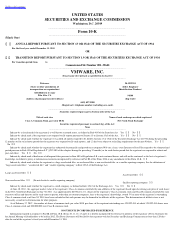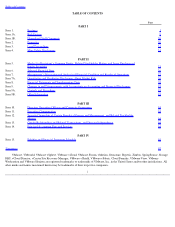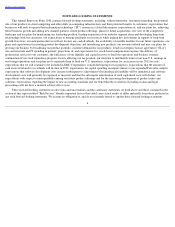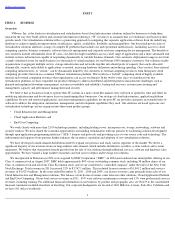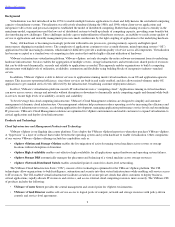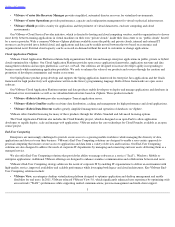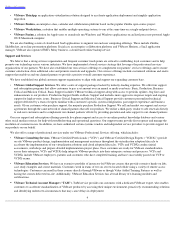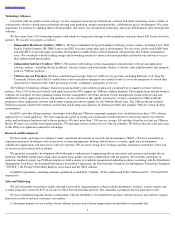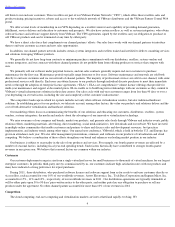VMware 2011 Annual Report Download - page 12
Download and view the complete annual report
Please find page 12 of the 2011 VMware annual report below. You can navigate through the pages in the report by either clicking on the pages listed below, or by using the keyword search tool below to find specific information within the annual report.
Table of Contents
experienced increased competition during 2011 and expect it to significantly intensify in the future. We compete with large and small vendors in
different segments of the cloud computing, end-user computing and virtualization markets, and expect that new entrants will continue to enter
the market and develop technologies that, if commercialized, may compete with our products.
We believe the key competitive factors in the cloud computing, end-user computing and virtualization markets include:
The cloud computing market is in a high state of flux with both established and new technology companies vying for thought leadership and
market share. Currently, Amazon EC2, Microsoft Azure and emerging open source efforts present alternatives to VMware's hybrid cloud
computing vision.
Microsoft is also our primary competitor for data center virtualization solutions. In 2011 , Microsoft continued to release incremental
improvements to its Hyper-V virtualization offering and System Center suite of virtualization management products and is expected to release
another major version of Hyper-V in 2012. Microsoft's offerings are positioned to compete with our virtual infrastructure, virtualization
management and some of our free data center product offerings.
We also compete with Citrix and its collaborations with Microsoft for end-user computing solutions and with companies whose
virtualization products are based on emerging open source technologies. In addition, we compete with companies that take different approaches
to virtualization. Furthermore, our VMware vSphere suites compete with products that provide high availability clustering, workload
management and resource management.
We also expect to compete with new entrants to the cloud computing, end-user computing and virtualization markets, which may include
parties currently selling our products and/or our current technology partners. Existing and future competitors may introduce products in the same
markets we serve or intend to serve, and competing products may have better performance, lower prices, better functionality and broader
acceptance than our products. Our competitors may also add features to their cloud computing, end-user computing and virtualization products
that are similar to features that presently differentiate our product offerings from theirs. Additionally, some of our competitors may make
acquisitions or enter into partnerships or other strategic relationships with one another to offer more comprehensive solutions than those they
individually had offered. Some competitors have in the past, and may in the future, take advantage of their existing relationships with our
business partners to engage in business practices such as distribution and license restrictions that make our products less attractive to our channel
partners and end users.
Information technology companies are also increasingly seeking to deliver top-to-bottom IT solutions to end users that combine enterprise-
level hardware and software solutions that can offer alternatives to our cloud computing, end-user computing and virtualization platform. In
addition, competitors who have existing relationships with our current or prospective end users could integrate competitive capabilities into their
existing products and make them available without additional charge. Many of our current and potential competitors have longer operating
histories, greater name recognition, a larger customer base and significantly greater financial, technical, sales and marketing and other resources
than we do.
Overall however, we believe our market position, large virtualization customer base, strong network of partners and indirect sales, broad and
innovative solutions suite, and platform-agnostic approach position us to compete effectively.
7
•
the level of reliability, interoperability and new functionality of product offerings;
•
the ability to provide comprehensive solutions, including management capabilities;
• the ability to offer products that support multiple hardware platforms, operating systems, applications and application development
frameworks;
• the ability to deliver an intuitive end-user experience for accessing data, applications and services from a wide variety of end-user
devices;
•
a proven track record of formulating and delivering a roadmap of compelling software and service capabilities;
•
pricing of products, individually and in bundles;
•
the ability to attract and preserve a large installed base of customers;
•
the ability to attract and maintain a large number of application developers for a given cloud ecosystem;
• the ability to create and maintain partnering opportunities with hardware vendors, infrastructure software vendors and cloud service
providers;
•
the ability to develop robust indirect sales channels; and
•
the ability to attract and retain cloud, virtualization and systems experts as key employees.


